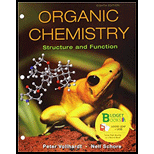
(a)
Interpretation: The Lewis acid-base process of bromoethane with
Concept Introduction:
In general, an acid can be defined as the substance which can give ions whereas a base can be defined as the molecule which can give ions. This theory of acid and base is also called an
Another concept for acid and base compounds is called Lewis acid-base theory. According to this, an acidic compound is an electron-deficient compound that can accept electron whereas a basic compound must be with extra electrons in the form of lone pairs or negative charge that can be given to Lewis acid to form the salt.
(b)
Interpretation: The Lewis acid-base process of propanal with
Concept Introduction:
In general, an acid can be defined as the substance which can give ions whereas a base can be defined as the molecule which can give ions. This theory of acid and base is also called an Arrhenius theory of acid and base.
Another concept for acid and base compounds is called Lewis acid-base theory. According to this, an acidic compound is an electron-deficient compound that can accept electron whereas a basic compound must be with extra electrons in the form of lone pairs or negative charge that can be given to Lewis acid to form the salt.
(c)
Interpretation: The Lewis acid-base process of methoxyethane with
Concept Introduction:
In general, an acid can be defined as the substance which can give ions whereas a base can be defined as the molecule which can give ions. This theory of acid and base is also called an Arrhenius theory of acid and base.
Another concept for acid and base compounds is called Lewis acid-base theory. According to this, an acidic compound is an electron-deficient compound that can accept electron whereas a basic compound must be with extra electrons in the form of lone pairs or negative charge that can be given to Lewis acid to form the salt.
(d)
Interpretation: The Lewis acid-base process of 3-hexanone with
Concept Introduction:
In general, an acid can be defined as the substance which can give ions whereas a base can be defined as the molecule which can give ions. This theory of acid and base is also called an Arrhenius theory of acid and base.
Another concept for acid and base compounds is called Lewis acid-base theory. According to this, an acidic compound is an electron-deficient compound that can accept electron whereas a basic compound must be with extra electrons in the form of lone pairs or negative charge that can be given to Lewis acid to form the salt.
(e)
Interpretation: The Lewis acid-base process of ethanenitrile with
Concept Introduction:
In general, an acid can be defined as the substance which can give ions whereas a base can be defined as the molecule which can give ions. This theory of acid and base is also called an Arrhenius theory of acid and base.
Another concept for acid and base compounds is called Lewis acid-base theory. According to this, an acidic compound is an electron-deficient compound that can accept electron whereas a basic compound must be with extra electrons in the form of lone pairs or negative charge that can be given to Lewis acid to form the salt.
(f)
Interpretation: The Lewis acid-base process of butane with
Concept Introduction:
In general, an acid can be defined as the substance which can give ions whereas a base can be defined as the molecule which can give ions. This theory of acid and base is also called an Arrhenius theory of acid and base.
Another concept for acid and base compounds is called Lewis acid-base theory. According to this, an acidic compound is an electron-deficient compound that can accept electron whereas a basic compound must be with extra electrons in the form of lone pairs or negative charge that can be given to Lewis acid to form the salt.
Want to see the full answer?
Check out a sample textbook solution
Chapter 2 Solutions
ORGANIC CHEMISTRY (LL)-PACKAGE
- Select the stronger base from each pair of compounds. (a) H₂CNH₂ or EtzN (b) CI or NH2 NH2 (c) .Q or EtzN (d) or (e) N or (f) H or Harrow_forward4. Provide a clear arrow-pushing mechanism for each of the following reactions. Do not skip proton transfers, do not combine steps, and make sure your arrows are clear enough to be interpreted without ambiguity. a. 2. 1. LDA 3. H3O+ HOarrow_forwardb. H3C CH3 H3O+ ✓ H OHarrow_forward
- 2. Provide reagents/conditions to accomplish the following syntheses. More than one step is required in some cases. a. CH3arrow_forwardIdentify and provide an explanation that distinguishes a qualitative and quantitative chemical analysis. Provide examples.arrow_forwardIdentify and provide an explanation of the operational principles behind a Atomic Absorption Spectrometer (AAS). List the steps involved.arrow_forward
- Instructions: Complete the questions in the space provided. Show all your work 1. You are trying to determine the rate law expression for a reaction that you are completing at 25°C. You measure the initial reaction rate and the starting concentrations of the reactions for 4 trials. BrO³¯ (aq) + 5Br¯ (aq) + 6H* (aq) → 3Br₂ (l) + 3H2O (l) Initial rate Trial [BrO3] [H*] [Br] (mol/L) (mol/L) | (mol/L) (mol/L.s) 1 0.10 0.10 0.10 8.0 2 0.20 0.10 0.10 16 3 0.10 0.20 0.10 16 4 0.10 0.10 0.20 32 a. Based on the above data what is the rate law expression? b. Solve for the value of k (make sure to include proper units) 2. The proposed reaction mechanism is as follows: i. ii. BrО¸¯ (aq) + H+ (aq) → HBrO3 (aq) HBrO³ (aq) + H* (aq) → H₂BrO3* (aq) iii. H₂BrO³* (aq) + Br¯ (aq) → Br₂O₂ (aq) + H2O (l) [Fast] [Medium] [Slow] iv. Br₂O₂ (aq) + 4H*(aq) + 4Br(aq) → 3Br₂ (l) + H2O (l) [Fast] Evaluate the validity of this proposed reaction. Justify your answer.arrow_forwardе. Д CH3 D*, D20arrow_forwardC. NaOMe, Br Brarrow_forward
